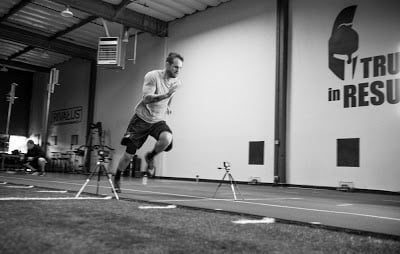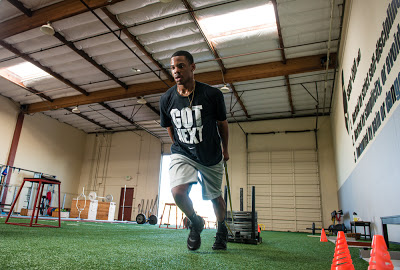
Last week in Part I, we talked about the 40 Yard Dash and how it has become such an important test for football players. We also talked about the start, and the importance of proper body positions for GRF based on each athlete’s Movement Signature.
Today, we move into the acceleration phase of the 40, particularly the first 10 yards. Not only is the first 10 yards the most important part of running a fast 40 yard time, but it is also arguably a better indicator of speed for football players since acceleration and change of direction are such important parts of the game.
To summarize the first 10 yards, it is all about stride length. Driving the ground (producing GRF) and maintaining long, efficient body positions is the key to acceleration. It is not uncommon to see an athletes who are moving their feet really fast, or who look they are working really hard in the first 10. While these athletes might look fast, they are often some of the slowest because they are spinning their wheels and fighting the air with their arms. Learning to drive the ground will transform the way they run.
Maintaining a good body position for acceleration is all about preventing GRF from leaking out of the system. Forces travel best in straight lines. Any deviation from a straight line diminishes the “equal and opposite” effect of the force that was produced into the ground. We often see particular Movement Signatures that leak force in a certain way. For example:

Flexed: round their upper back and are not able to get full hip extension with every stride
Hinge: are unable to get full knee flexion on the front side and “break” at the waist
Swing: use too much rotation in torso and have cross-body arm action
Loose: lack lower leg stiffness on ground contact and reach for long strides rather than driving for long strides.
These force leaks have an impact on sprint technique and speed, but they are really a result of how each individual moves, and must be addressed through an individual approach of strength, skills, and regen work. It’s not just better sprint technique that makes athletes faster, it is better movement technique.
So, running fast comes down to driving the ground and not leaking force. There is a simple progression that will allow you to master these qualities and significantly improve your speed.
Step 1 – Wall Drills are the foundation for learning sprint positions. Become a master, and always refresh the basics as a part of your warm-up.
Step 2 – Sled March is the best drill for combining sprint technique and body position with GRF. If you can only do one speed drill, do sled marches.
Step 3 – Acceleration Bounds are the ultimate teaching tool for sprint technique. Use video feedback to analyze your form.
Practice these exercises, and all that’s left to do is run. Don’t run 400s or 100s or 60s or 40s. Run 10 yard sprints over and over and over again. Not only will this have the biggest impact on your 40 or 60 time, but it will also have the most carryover to game speed.